Entrepreneurship and Small Business Management: Ventures Analysis
VerifiedAdded on 2022/12/26
|22
|6730
|71
Report
AI Summary
This report provides a comprehensive analysis of entrepreneurial ventures, exploring their typology, economic impact, and the characteristics of successful entrepreneurs. It examines various types of entrepreneurship, including small business, scalable start-ups, large company, and social entrepreneurship, highlighting their similarities and differences. The report evaluates the impact of micro and small businesses on the economy, emphasizing their importance to social and economic growth. Furthermore, it identifies the key traits and skills that differentiate successful entrepreneurs from other business managers, assessing how entrepreneurial personality reflects motivation and mindset. Finally, the report investigates how background and experience can either hinder or foster entrepreneurship, providing specific examples to support the analysis. Desklib offers a platform to access this and many more solved assignments.

Entrepreneurship and Small
Business Management
Business Management
Paraphrase This Document
Need a fresh take? Get an instant paraphrase of this document with our AI Paraphraser
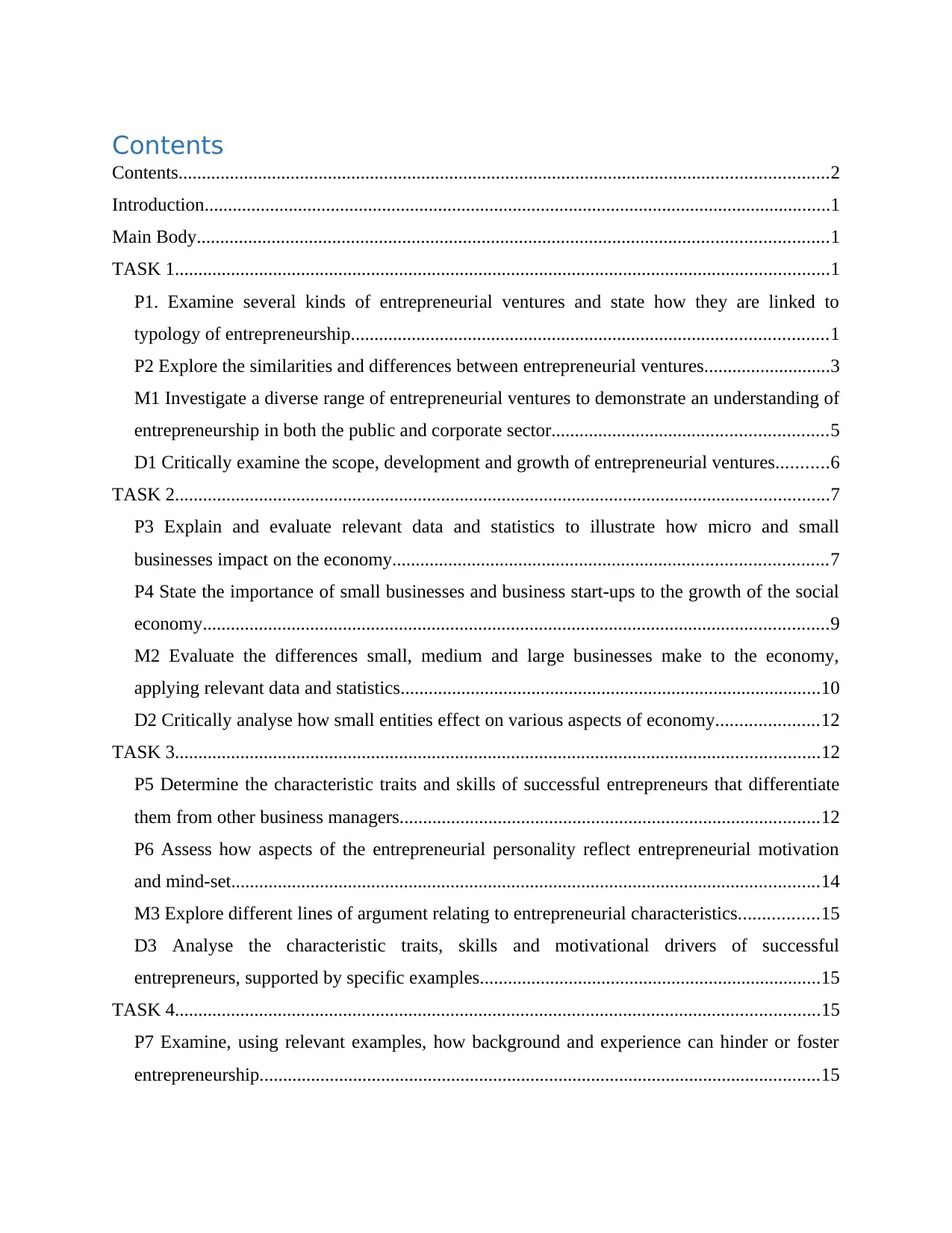
Contents
Contents...........................................................................................................................................2
Introduction......................................................................................................................................1
Main Body.......................................................................................................................................1
TASK 1............................................................................................................................................1
P1. Examine several kinds of entrepreneurial ventures and state how they are linked to
typology of entrepreneurship......................................................................................................1
P2 Explore the similarities and differences between entrepreneurial ventures...........................3
M1 Investigate a diverse range of entrepreneurial ventures to demonstrate an understanding of
entrepreneurship in both the public and corporate sector...........................................................5
D1 Critically examine the scope, development and growth of entrepreneurial ventures...........6
TASK 2............................................................................................................................................7
P3 Explain and evaluate relevant data and statistics to illustrate how micro and small
businesses impact on the economy.............................................................................................7
P4 State the importance of small businesses and business start-ups to the growth of the social
economy......................................................................................................................................9
M2 Evaluate the differences small, medium and large businesses make to the economy,
applying relevant data and statistics..........................................................................................10
D2 Critically analyse how small entities effect on various aspects of economy......................12
TASK 3..........................................................................................................................................12
P5 Determine the characteristic traits and skills of successful entrepreneurs that differentiate
them from other business managers..........................................................................................12
P6 Assess how aspects of the entrepreneurial personality reflect entrepreneurial motivation
and mind-set..............................................................................................................................14
M3 Explore different lines of argument relating to entrepreneurial characteristics.................15
D3 Analyse the characteristic traits, skills and motivational drivers of successful
entrepreneurs, supported by specific examples.........................................................................15
TASK 4..........................................................................................................................................15
P7 Examine, using relevant examples, how background and experience can hinder or foster
entrepreneurship........................................................................................................................15
Contents...........................................................................................................................................2
Introduction......................................................................................................................................1
Main Body.......................................................................................................................................1
TASK 1............................................................................................................................................1
P1. Examine several kinds of entrepreneurial ventures and state how they are linked to
typology of entrepreneurship......................................................................................................1
P2 Explore the similarities and differences between entrepreneurial ventures...........................3
M1 Investigate a diverse range of entrepreneurial ventures to demonstrate an understanding of
entrepreneurship in both the public and corporate sector...........................................................5
D1 Critically examine the scope, development and growth of entrepreneurial ventures...........6
TASK 2............................................................................................................................................7
P3 Explain and evaluate relevant data and statistics to illustrate how micro and small
businesses impact on the economy.............................................................................................7
P4 State the importance of small businesses and business start-ups to the growth of the social
economy......................................................................................................................................9
M2 Evaluate the differences small, medium and large businesses make to the economy,
applying relevant data and statistics..........................................................................................10
D2 Critically analyse how small entities effect on various aspects of economy......................12
TASK 3..........................................................................................................................................12
P5 Determine the characteristic traits and skills of successful entrepreneurs that differentiate
them from other business managers..........................................................................................12
P6 Assess how aspects of the entrepreneurial personality reflect entrepreneurial motivation
and mind-set..............................................................................................................................14
M3 Explore different lines of argument relating to entrepreneurial characteristics.................15
D3 Analyse the characteristic traits, skills and motivational drivers of successful
entrepreneurs, supported by specific examples.........................................................................15
TASK 4..........................................................................................................................................15
P7 Examine, using relevant examples, how background and experience can hinder or foster
entrepreneurship........................................................................................................................15

M4 Analyse the link between entrepreneurial characteristics and the influence of personal
background and experience to specific successful entrepreneurs.............................................16
D4 Critically analyse from background and experience influences entrepreneurs...................17
Conclusion.....................................................................................................................................17
References......................................................................................................................................18
background and experience to specific successful entrepreneurs.............................................16
D4 Critically analyse from background and experience influences entrepreneurs...................17
Conclusion.....................................................................................................................................17
References......................................................................................................................................18
⊘ This is a preview!⊘
Do you want full access?
Subscribe today to unlock all pages.

Trusted by 1+ million students worldwide
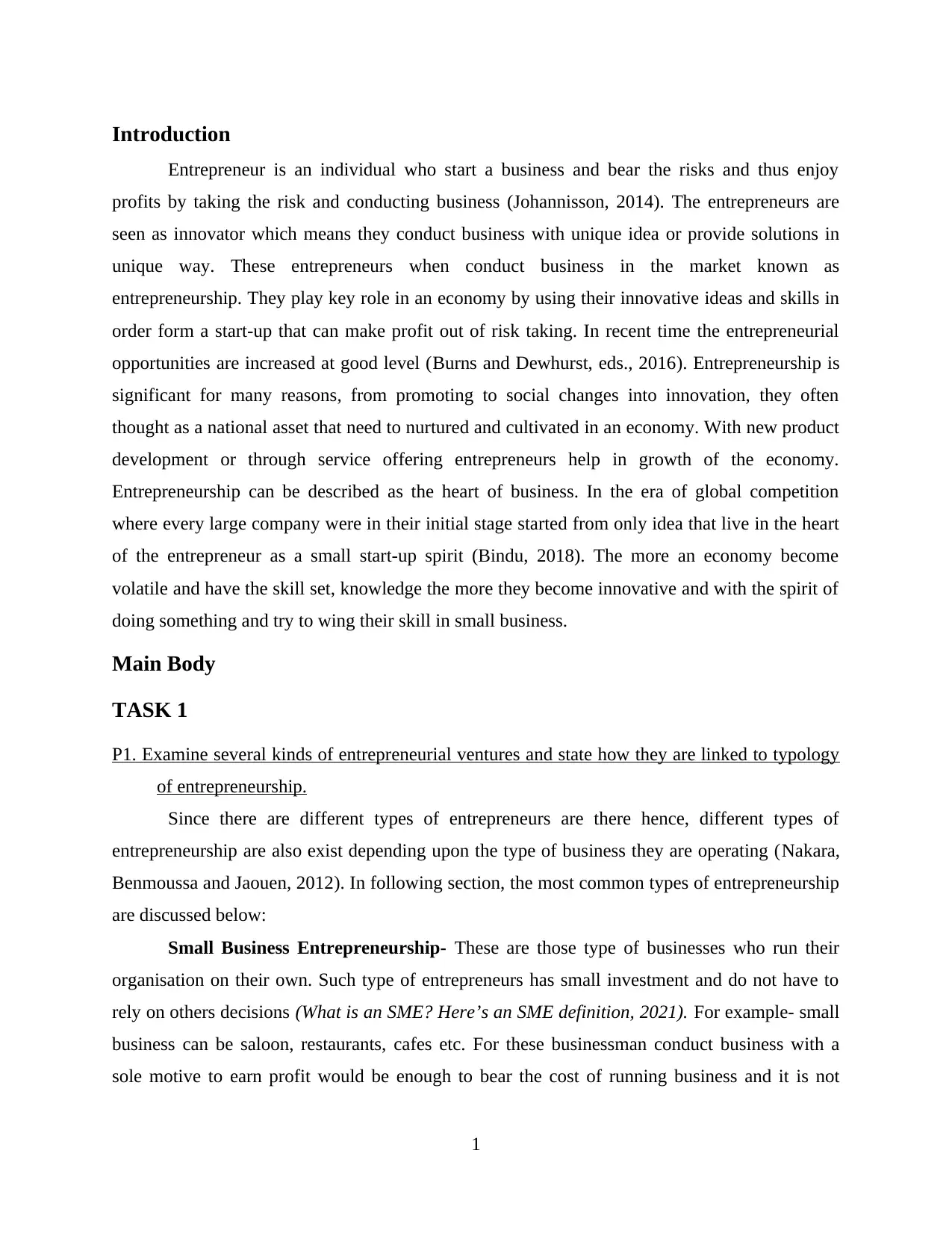
Introduction
Entrepreneur is an individual who start a business and bear the risks and thus enjoy
profits by taking the risk and conducting business (Johannisson, 2014). The entrepreneurs are
seen as innovator which means they conduct business with unique idea or provide solutions in
unique way. These entrepreneurs when conduct business in the market known as
entrepreneurship. They play key role in an economy by using their innovative ideas and skills in
order form a start-up that can make profit out of risk taking. In recent time the entrepreneurial
opportunities are increased at good level (Burns and Dewhurst, eds., 2016). Entrepreneurship is
significant for many reasons, from promoting to social changes into innovation, they often
thought as a national asset that need to nurtured and cultivated in an economy. With new product
development or through service offering entrepreneurs help in growth of the economy.
Entrepreneurship can be described as the heart of business. In the era of global competition
where every large company were in their initial stage started from only idea that live in the heart
of the entrepreneur as a small start-up spirit (Bindu, 2018). The more an economy become
volatile and have the skill set, knowledge the more they become innovative and with the spirit of
doing something and try to wing their skill in small business.
Main Body
TASK 1
P1. Examine several kinds of entrepreneurial ventures and state how they are linked to typology
of entrepreneurship.
Since there are different types of entrepreneurs are there hence, different types of
entrepreneurship are also exist depending upon the type of business they are operating (Nakara,
Benmoussa and Jaouen, 2012). In following section, the most common types of entrepreneurship
are discussed below:
Small Business Entrepreneurship- These are those type of businesses who run their
organisation on their own. Such type of entrepreneurs has small investment and do not have to
rely on others decisions (What is an SME? Here’s an SME definition, 2021). For example- small
business can be saloon, restaurants, cafes etc. For these businessman conduct business with a
sole motive to earn profit would be enough to bear the cost of running business and it is not
1
Entrepreneur is an individual who start a business and bear the risks and thus enjoy
profits by taking the risk and conducting business (Johannisson, 2014). The entrepreneurs are
seen as innovator which means they conduct business with unique idea or provide solutions in
unique way. These entrepreneurs when conduct business in the market known as
entrepreneurship. They play key role in an economy by using their innovative ideas and skills in
order form a start-up that can make profit out of risk taking. In recent time the entrepreneurial
opportunities are increased at good level (Burns and Dewhurst, eds., 2016). Entrepreneurship is
significant for many reasons, from promoting to social changes into innovation, they often
thought as a national asset that need to nurtured and cultivated in an economy. With new product
development or through service offering entrepreneurs help in growth of the economy.
Entrepreneurship can be described as the heart of business. In the era of global competition
where every large company were in their initial stage started from only idea that live in the heart
of the entrepreneur as a small start-up spirit (Bindu, 2018). The more an economy become
volatile and have the skill set, knowledge the more they become innovative and with the spirit of
doing something and try to wing their skill in small business.
Main Body
TASK 1
P1. Examine several kinds of entrepreneurial ventures and state how they are linked to typology
of entrepreneurship.
Since there are different types of entrepreneurs are there hence, different types of
entrepreneurship are also exist depending upon the type of business they are operating (Nakara,
Benmoussa and Jaouen, 2012). In following section, the most common types of entrepreneurship
are discussed below:
Small Business Entrepreneurship- These are those type of businesses who run their
organisation on their own. Such type of entrepreneurs has small investment and do not have to
rely on others decisions (What is an SME? Here’s an SME definition, 2021). For example- small
business can be saloon, restaurants, cafes etc. For these businessman conduct business with a
sole motive to earn profit would be enough to bear the cost of running business and it is not
1
Paraphrase This Document
Need a fresh take? Get an instant paraphrase of this document with our AI Paraphraser
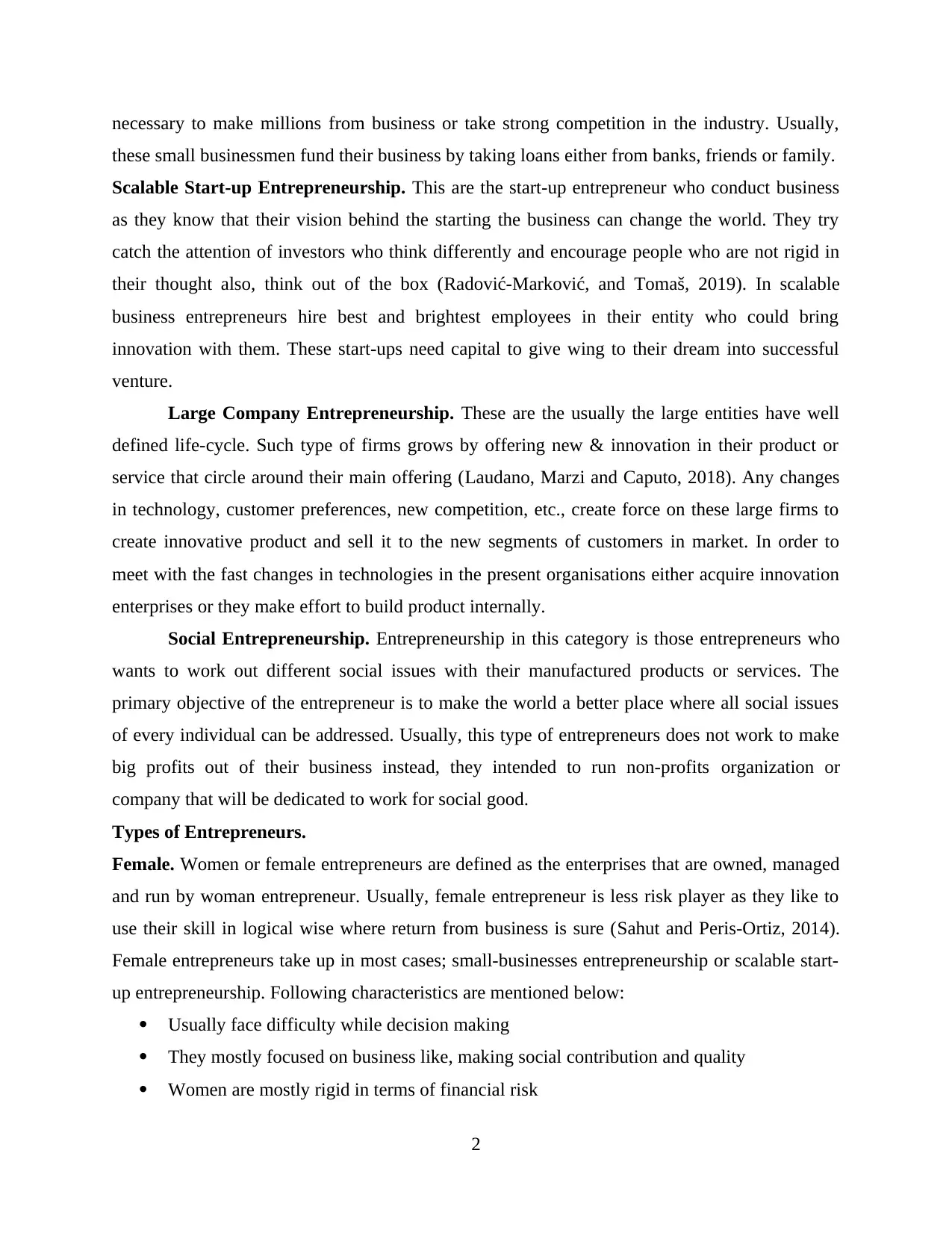
necessary to make millions from business or take strong competition in the industry. Usually,
these small businessmen fund their business by taking loans either from banks, friends or family.
Scalable Start-up Entrepreneurship. This are the start-up entrepreneur who conduct business
as they know that their vision behind the starting the business can change the world. They try
catch the attention of investors who think differently and encourage people who are not rigid in
their thought also, think out of the box (Radović-Marković, and Tomaš, 2019). In scalable
business entrepreneurs hire best and brightest employees in their entity who could bring
innovation with them. These start-ups need capital to give wing to their dream into successful
venture.
Large Company Entrepreneurship. These are the usually the large entities have well
defined life-cycle. Such type of firms grows by offering new & innovation in their product or
service that circle around their main offering (Laudano, Marzi and Caputo, 2018). Any changes
in technology, customer preferences, new competition, etc., create force on these large firms to
create innovative product and sell it to the new segments of customers in market. In order to
meet with the fast changes in technologies in the present organisations either acquire innovation
enterprises or they make effort to build product internally.
Social Entrepreneurship. Entrepreneurship in this category is those entrepreneurs who
wants to work out different social issues with their manufactured products or services. The
primary objective of the entrepreneur is to make the world a better place where all social issues
of every individual can be addressed. Usually, this type of entrepreneurs does not work to make
big profits out of their business instead, they intended to run non-profits organization or
company that will be dedicated to work for social good.
Types of Entrepreneurs.
Female. Women or female entrepreneurs are defined as the enterprises that are owned, managed
and run by woman entrepreneur. Usually, female entrepreneur is less risk player as they like to
use their skill in logical wise where return from business is sure (Sahut and Peris-Ortiz, 2014).
Female entrepreneurs take up in most cases; small-businesses entrepreneurship or scalable start-
up entrepreneurship. Following characteristics are mentioned below:
Usually face difficulty while decision making
They mostly focused on business like, making social contribution and quality
Women are mostly rigid in terms of financial risk
2
these small businessmen fund their business by taking loans either from banks, friends or family.
Scalable Start-up Entrepreneurship. This are the start-up entrepreneur who conduct business
as they know that their vision behind the starting the business can change the world. They try
catch the attention of investors who think differently and encourage people who are not rigid in
their thought also, think out of the box (Radović-Marković, and Tomaš, 2019). In scalable
business entrepreneurs hire best and brightest employees in their entity who could bring
innovation with them. These start-ups need capital to give wing to their dream into successful
venture.
Large Company Entrepreneurship. These are the usually the large entities have well
defined life-cycle. Such type of firms grows by offering new & innovation in their product or
service that circle around their main offering (Laudano, Marzi and Caputo, 2018). Any changes
in technology, customer preferences, new competition, etc., create force on these large firms to
create innovative product and sell it to the new segments of customers in market. In order to
meet with the fast changes in technologies in the present organisations either acquire innovation
enterprises or they make effort to build product internally.
Social Entrepreneurship. Entrepreneurship in this category is those entrepreneurs who
wants to work out different social issues with their manufactured products or services. The
primary objective of the entrepreneur is to make the world a better place where all social issues
of every individual can be addressed. Usually, this type of entrepreneurs does not work to make
big profits out of their business instead, they intended to run non-profits organization or
company that will be dedicated to work for social good.
Types of Entrepreneurs.
Female. Women or female entrepreneurs are defined as the enterprises that are owned, managed
and run by woman entrepreneur. Usually, female entrepreneur is less risk player as they like to
use their skill in logical wise where return from business is sure (Sahut and Peris-Ortiz, 2014).
Female entrepreneurs take up in most cases; small-businesses entrepreneurship or scalable start-
up entrepreneurship. Following characteristics are mentioned below:
Usually face difficulty while decision making
They mostly focused on business like, making social contribution and quality
Women are mostly rigid in terms of financial risk
2
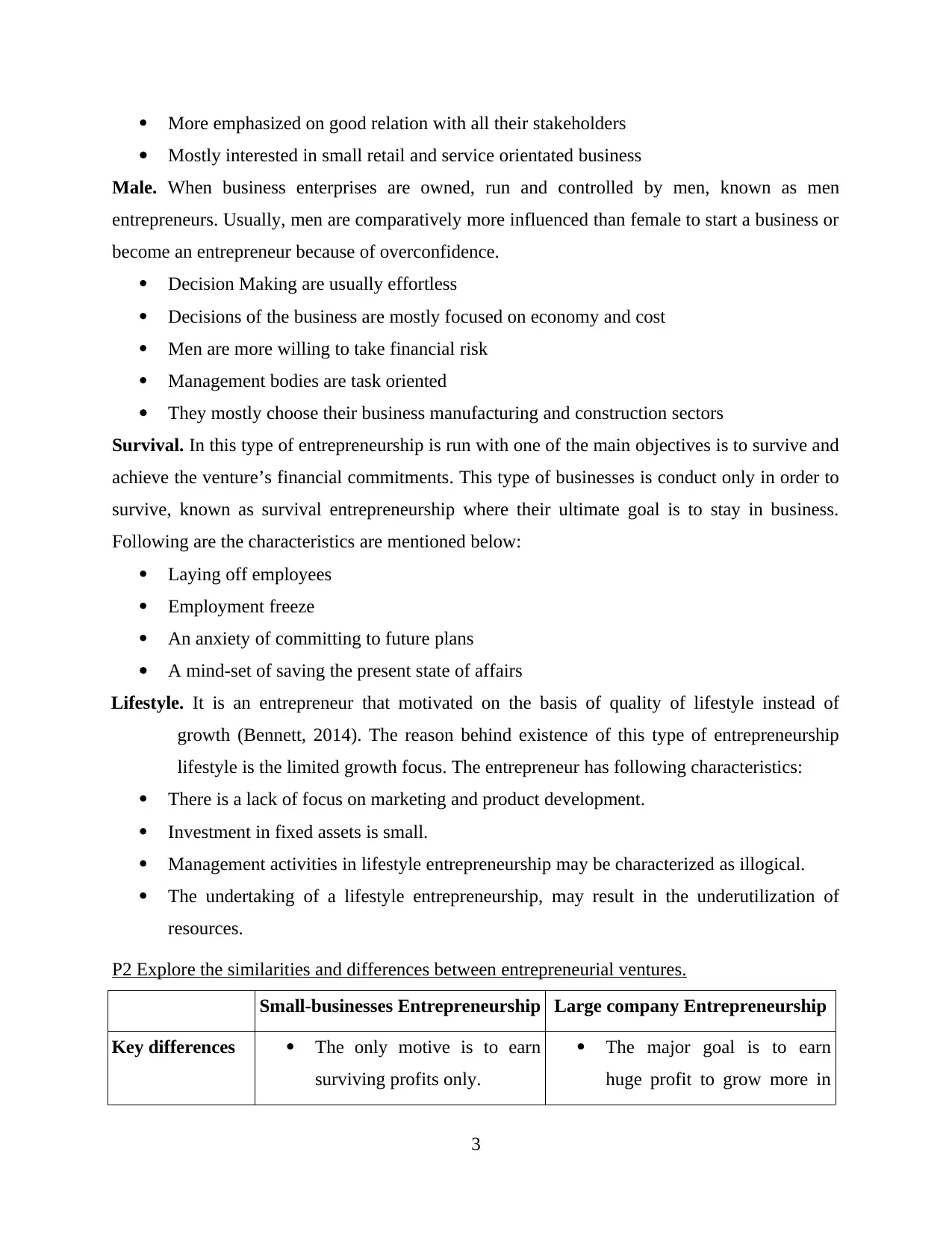
More emphasized on good relation with all their stakeholders
Mostly interested in small retail and service orientated business
Male. When business enterprises are owned, run and controlled by men, known as men
entrepreneurs. Usually, men are comparatively more influenced than female to start a business or
become an entrepreneur because of overconfidence.
Decision Making are usually effortless
Decisions of the business are mostly focused on economy and cost
Men are more willing to take financial risk
Management bodies are task oriented
They mostly choose their business manufacturing and construction sectors
Survival. In this type of entrepreneurship is run with one of the main objectives is to survive and
achieve the venture’s financial commitments. This type of businesses is conduct only in order to
survive, known as survival entrepreneurship where their ultimate goal is to stay in business.
Following are the characteristics are mentioned below:
Laying off employees
Employment freeze
An anxiety of committing to future plans
A mind-set of saving the present state of affairs
Lifestyle. It is an entrepreneur that motivated on the basis of quality of lifestyle instead of
growth (Bennett, 2014). The reason behind existence of this type of entrepreneurship
lifestyle is the limited growth focus. The entrepreneur has following characteristics:
There is a lack of focus on marketing and product development.
Investment in fixed assets is small.
Management activities in lifestyle entrepreneurship may be characterized as illogical.
The undertaking of a lifestyle entrepreneurship, may result in the underutilization of
resources.
P2 Explore the similarities and differences between entrepreneurial ventures.
Small-businesses Entrepreneurship Large company Entrepreneurship
Key differences The only motive is to earn
surviving profits only.
The major goal is to earn
huge profit to grow more in
3
Mostly interested in small retail and service orientated business
Male. When business enterprises are owned, run and controlled by men, known as men
entrepreneurs. Usually, men are comparatively more influenced than female to start a business or
become an entrepreneur because of overconfidence.
Decision Making are usually effortless
Decisions of the business are mostly focused on economy and cost
Men are more willing to take financial risk
Management bodies are task oriented
They mostly choose their business manufacturing and construction sectors
Survival. In this type of entrepreneurship is run with one of the main objectives is to survive and
achieve the venture’s financial commitments. This type of businesses is conduct only in order to
survive, known as survival entrepreneurship where their ultimate goal is to stay in business.
Following are the characteristics are mentioned below:
Laying off employees
Employment freeze
An anxiety of committing to future plans
A mind-set of saving the present state of affairs
Lifestyle. It is an entrepreneur that motivated on the basis of quality of lifestyle instead of
growth (Bennett, 2014). The reason behind existence of this type of entrepreneurship
lifestyle is the limited growth focus. The entrepreneur has following characteristics:
There is a lack of focus on marketing and product development.
Investment in fixed assets is small.
Management activities in lifestyle entrepreneurship may be characterized as illogical.
The undertaking of a lifestyle entrepreneurship, may result in the underutilization of
resources.
P2 Explore the similarities and differences between entrepreneurial ventures.
Small-businesses Entrepreneurship Large company Entrepreneurship
Key differences The only motive is to earn
surviving profits only.
The major goal is to earn
huge profit to grow more in
3
⊘ This is a preview!⊘
Do you want full access?
Subscribe today to unlock all pages.

Trusted by 1+ million students worldwide
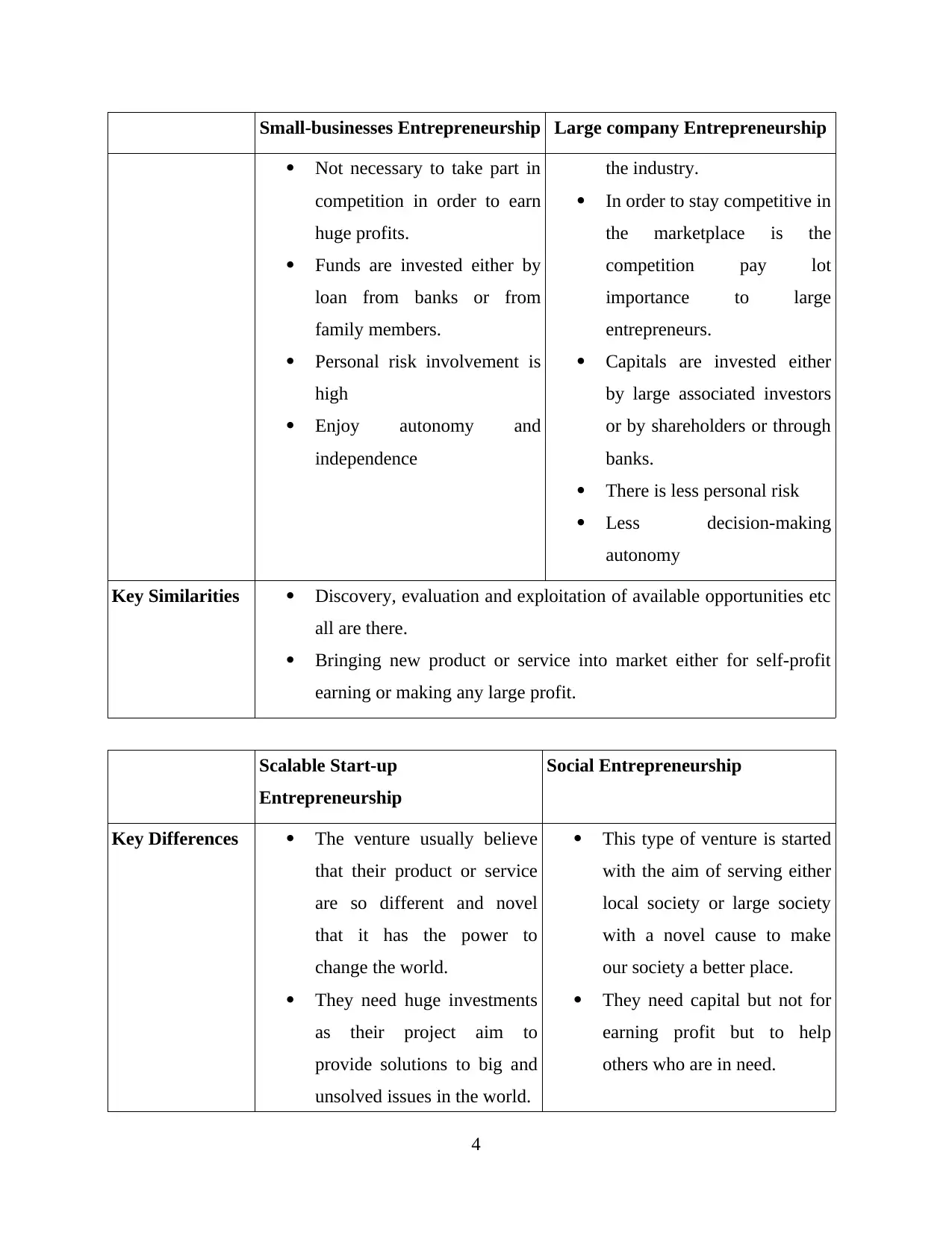
Small-businesses Entrepreneurship Large company Entrepreneurship
Not necessary to take part in
competition in order to earn
huge profits.
Funds are invested either by
loan from banks or from
family members.
Personal risk involvement is
high
Enjoy autonomy and
independence
the industry.
In order to stay competitive in
the marketplace is the
competition pay lot
importance to large
entrepreneurs.
Capitals are invested either
by large associated investors
or by shareholders or through
banks.
There is less personal risk
Less decision-making
autonomy
Key Similarities Discovery, evaluation and exploitation of available opportunities etc
all are there.
Bringing new product or service into market either for self-profit
earning or making any large profit.
Scalable Start-up
Entrepreneurship
Social Entrepreneurship
Key Differences The venture usually believe
that their product or service
are so different and novel
that it has the power to
change the world.
They need huge investments
as their project aim to
provide solutions to big and
unsolved issues in the world.
This type of venture is started
with the aim of serving either
local society or large society
with a novel cause to make
our society a better place.
They need capital but not for
earning profit but to help
others who are in need.
4
Not necessary to take part in
competition in order to earn
huge profits.
Funds are invested either by
loan from banks or from
family members.
Personal risk involvement is
high
Enjoy autonomy and
independence
the industry.
In order to stay competitive in
the marketplace is the
competition pay lot
importance to large
entrepreneurs.
Capitals are invested either
by large associated investors
or by shareholders or through
banks.
There is less personal risk
Less decision-making
autonomy
Key Similarities Discovery, evaluation and exploitation of available opportunities etc
all are there.
Bringing new product or service into market either for self-profit
earning or making any large profit.
Scalable Start-up
Entrepreneurship
Social Entrepreneurship
Key Differences The venture usually believe
that their product or service
are so different and novel
that it has the power to
change the world.
They need huge investments
as their project aim to
provide solutions to big and
unsolved issues in the world.
This type of venture is started
with the aim of serving either
local society or large society
with a novel cause to make
our society a better place.
They need capital but not for
earning profit but to help
others who are in need.
4
Paraphrase This Document
Need a fresh take? Get an instant paraphrase of this document with our AI Paraphraser
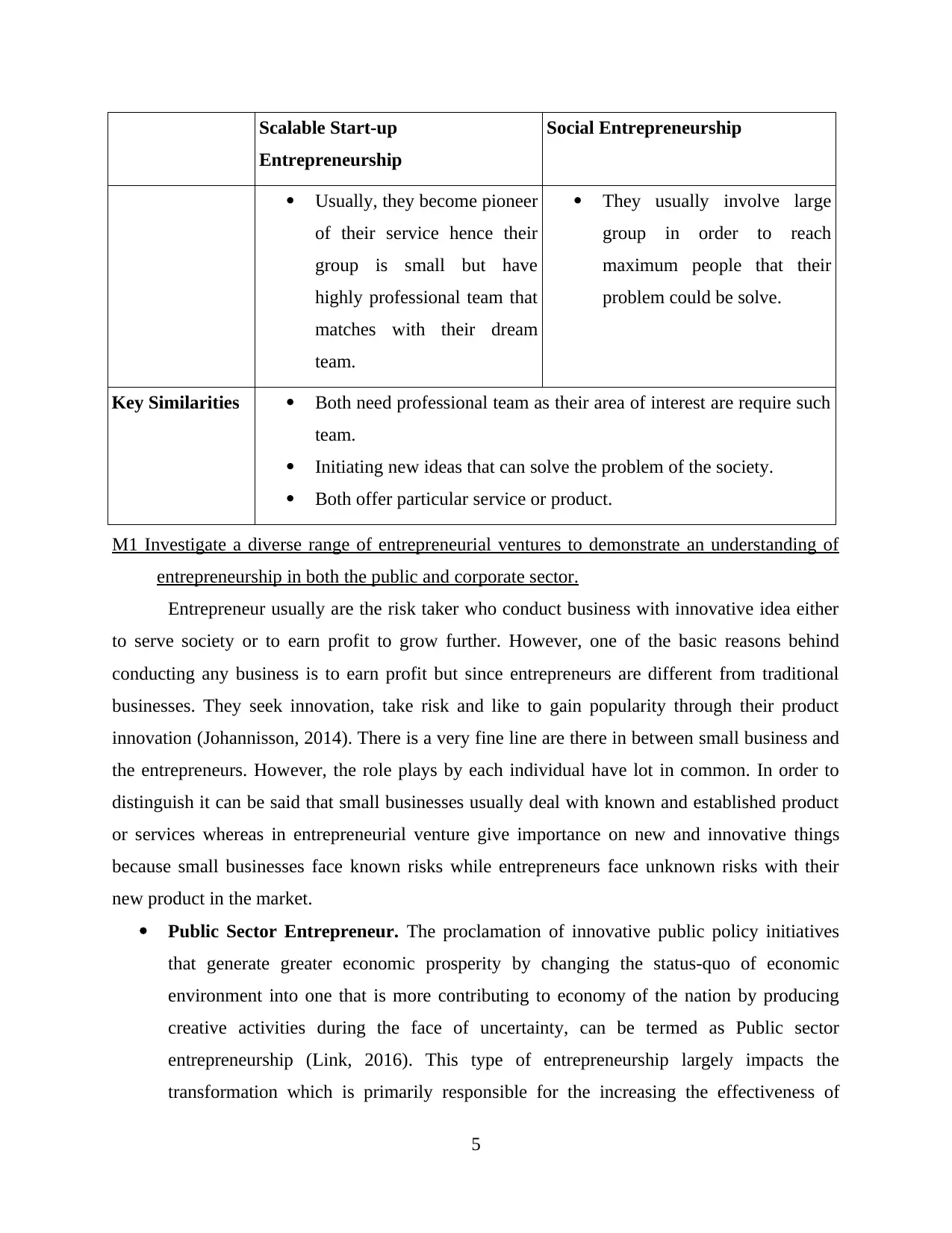
Scalable Start-up
Entrepreneurship
Social Entrepreneurship
Usually, they become pioneer
of their service hence their
group is small but have
highly professional team that
matches with their dream
team.
They usually involve large
group in order to reach
maximum people that their
problem could be solve.
Key Similarities Both need professional team as their area of interest are require such
team.
Initiating new ideas that can solve the problem of the society.
Both offer particular service or product.
M1 Investigate a diverse range of entrepreneurial ventures to demonstrate an understanding of
entrepreneurship in both the public and corporate sector.
Entrepreneur usually are the risk taker who conduct business with innovative idea either
to serve society or to earn profit to grow further. However, one of the basic reasons behind
conducting any business is to earn profit but since entrepreneurs are different from traditional
businesses. They seek innovation, take risk and like to gain popularity through their product
innovation (Johannisson, 2014). There is a very fine line are there in between small business and
the entrepreneurs. However, the role plays by each individual have lot in common. In order to
distinguish it can be said that small businesses usually deal with known and established product
or services whereas in entrepreneurial venture give importance on new and innovative things
because small businesses face known risks while entrepreneurs face unknown risks with their
new product in the market.
Public Sector Entrepreneur. The proclamation of innovative public policy initiatives
that generate greater economic prosperity by changing the status-quo of economic
environment into one that is more contributing to economy of the nation by producing
creative activities during the face of uncertainty, can be termed as Public sector
entrepreneurship (Link, 2016). This type of entrepreneurship largely impacts the
transformation which is primarily responsible for the increasing the effectiveness of
5
Entrepreneurship
Social Entrepreneurship
Usually, they become pioneer
of their service hence their
group is small but have
highly professional team that
matches with their dream
team.
They usually involve large
group in order to reach
maximum people that their
problem could be solve.
Key Similarities Both need professional team as their area of interest are require such
team.
Initiating new ideas that can solve the problem of the society.
Both offer particular service or product.
M1 Investigate a diverse range of entrepreneurial ventures to demonstrate an understanding of
entrepreneurship in both the public and corporate sector.
Entrepreneur usually are the risk taker who conduct business with innovative idea either
to serve society or to earn profit to grow further. However, one of the basic reasons behind
conducting any business is to earn profit but since entrepreneurs are different from traditional
businesses. They seek innovation, take risk and like to gain popularity through their product
innovation (Johannisson, 2014). There is a very fine line are there in between small business and
the entrepreneurs. However, the role plays by each individual have lot in common. In order to
distinguish it can be said that small businesses usually deal with known and established product
or services whereas in entrepreneurial venture give importance on new and innovative things
because small businesses face known risks while entrepreneurs face unknown risks with their
new product in the market.
Public Sector Entrepreneur. The proclamation of innovative public policy initiatives
that generate greater economic prosperity by changing the status-quo of economic
environment into one that is more contributing to economy of the nation by producing
creative activities during the face of uncertainty, can be termed as Public sector
entrepreneurship (Link, 2016). This type of entrepreneurship largely impacts the
transformation which is primarily responsible for the increasing the effectiveness of
5
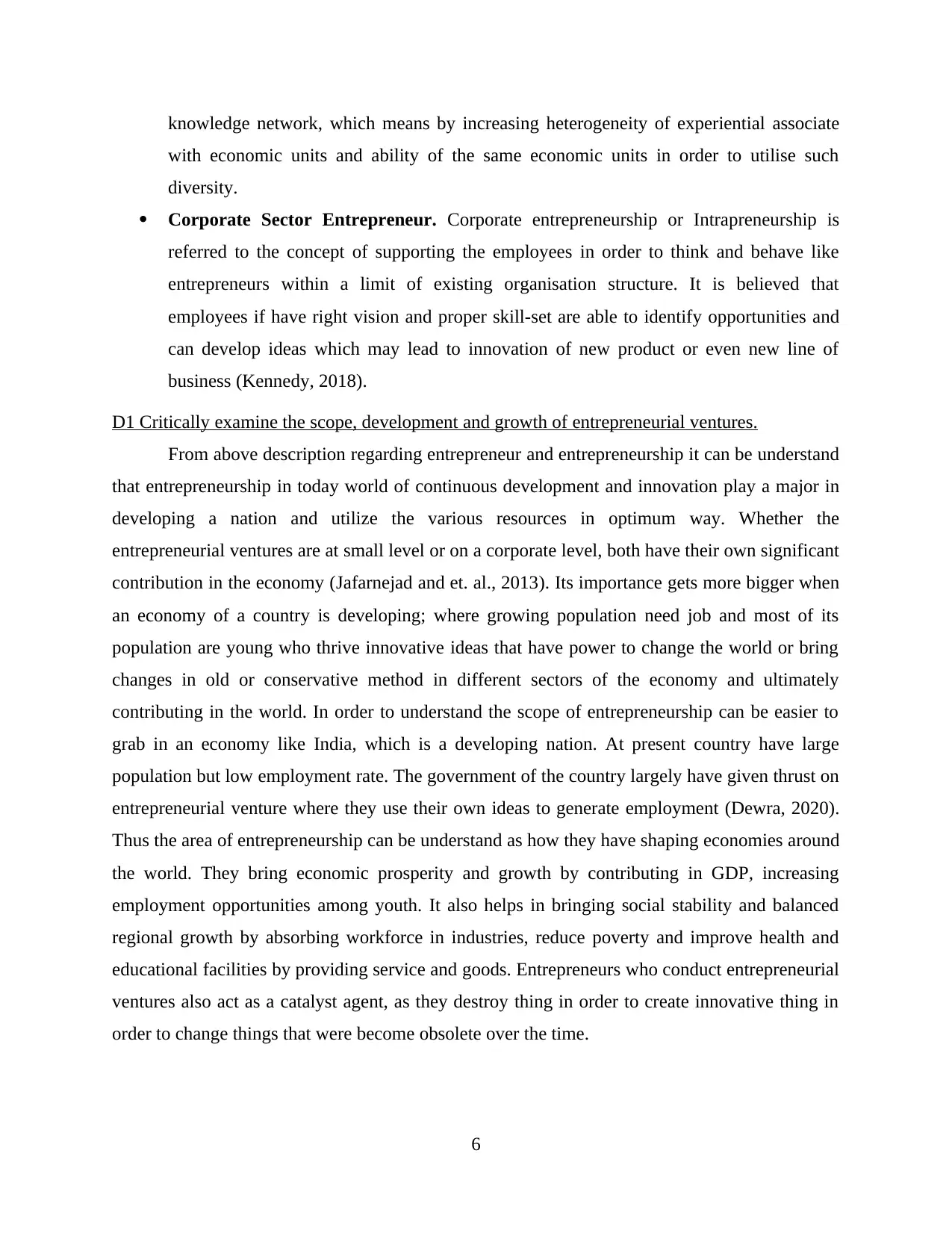
knowledge network, which means by increasing heterogeneity of experiential associate
with economic units and ability of the same economic units in order to utilise such
diversity.
Corporate Sector Entrepreneur. Corporate entrepreneurship or Intrapreneurship is
referred to the concept of supporting the employees in order to think and behave like
entrepreneurs within a limit of existing organisation structure. It is believed that
employees if have right vision and proper skill-set are able to identify opportunities and
can develop ideas which may lead to innovation of new product or even new line of
business (Kennedy, 2018).
D1 Critically examine the scope, development and growth of entrepreneurial ventures.
From above description regarding entrepreneur and entrepreneurship it can be understand
that entrepreneurship in today world of continuous development and innovation play a major in
developing a nation and utilize the various resources in optimum way. Whether the
entrepreneurial ventures are at small level or on a corporate level, both have their own significant
contribution in the economy (Jafarnejad and et. al., 2013). Its importance gets more bigger when
an economy of a country is developing; where growing population need job and most of its
population are young who thrive innovative ideas that have power to change the world or bring
changes in old or conservative method in different sectors of the economy and ultimately
contributing in the world. In order to understand the scope of entrepreneurship can be easier to
grab in an economy like India, which is a developing nation. At present country have large
population but low employment rate. The government of the country largely have given thrust on
entrepreneurial venture where they use their own ideas to generate employment (Dewra, 2020).
Thus the area of entrepreneurship can be understand as how they have shaping economies around
the world. They bring economic prosperity and growth by contributing in GDP, increasing
employment opportunities among youth. It also helps in bringing social stability and balanced
regional growth by absorbing workforce in industries, reduce poverty and improve health and
educational facilities by providing service and goods. Entrepreneurs who conduct entrepreneurial
ventures also act as a catalyst agent, as they destroy thing in order to create innovative thing in
order to change things that were become obsolete over the time.
6
with economic units and ability of the same economic units in order to utilise such
diversity.
Corporate Sector Entrepreneur. Corporate entrepreneurship or Intrapreneurship is
referred to the concept of supporting the employees in order to think and behave like
entrepreneurs within a limit of existing organisation structure. It is believed that
employees if have right vision and proper skill-set are able to identify opportunities and
can develop ideas which may lead to innovation of new product or even new line of
business (Kennedy, 2018).
D1 Critically examine the scope, development and growth of entrepreneurial ventures.
From above description regarding entrepreneur and entrepreneurship it can be understand
that entrepreneurship in today world of continuous development and innovation play a major in
developing a nation and utilize the various resources in optimum way. Whether the
entrepreneurial ventures are at small level or on a corporate level, both have their own significant
contribution in the economy (Jafarnejad and et. al., 2013). Its importance gets more bigger when
an economy of a country is developing; where growing population need job and most of its
population are young who thrive innovative ideas that have power to change the world or bring
changes in old or conservative method in different sectors of the economy and ultimately
contributing in the world. In order to understand the scope of entrepreneurship can be easier to
grab in an economy like India, which is a developing nation. At present country have large
population but low employment rate. The government of the country largely have given thrust on
entrepreneurial venture where they use their own ideas to generate employment (Dewra, 2020).
Thus the area of entrepreneurship can be understand as how they have shaping economies around
the world. They bring economic prosperity and growth by contributing in GDP, increasing
employment opportunities among youth. It also helps in bringing social stability and balanced
regional growth by absorbing workforce in industries, reduce poverty and improve health and
educational facilities by providing service and goods. Entrepreneurs who conduct entrepreneurial
ventures also act as a catalyst agent, as they destroy thing in order to create innovative thing in
order to change things that were become obsolete over the time.
6
⊘ This is a preview!⊘
Do you want full access?
Subscribe today to unlock all pages.

Trusted by 1+ million students worldwide
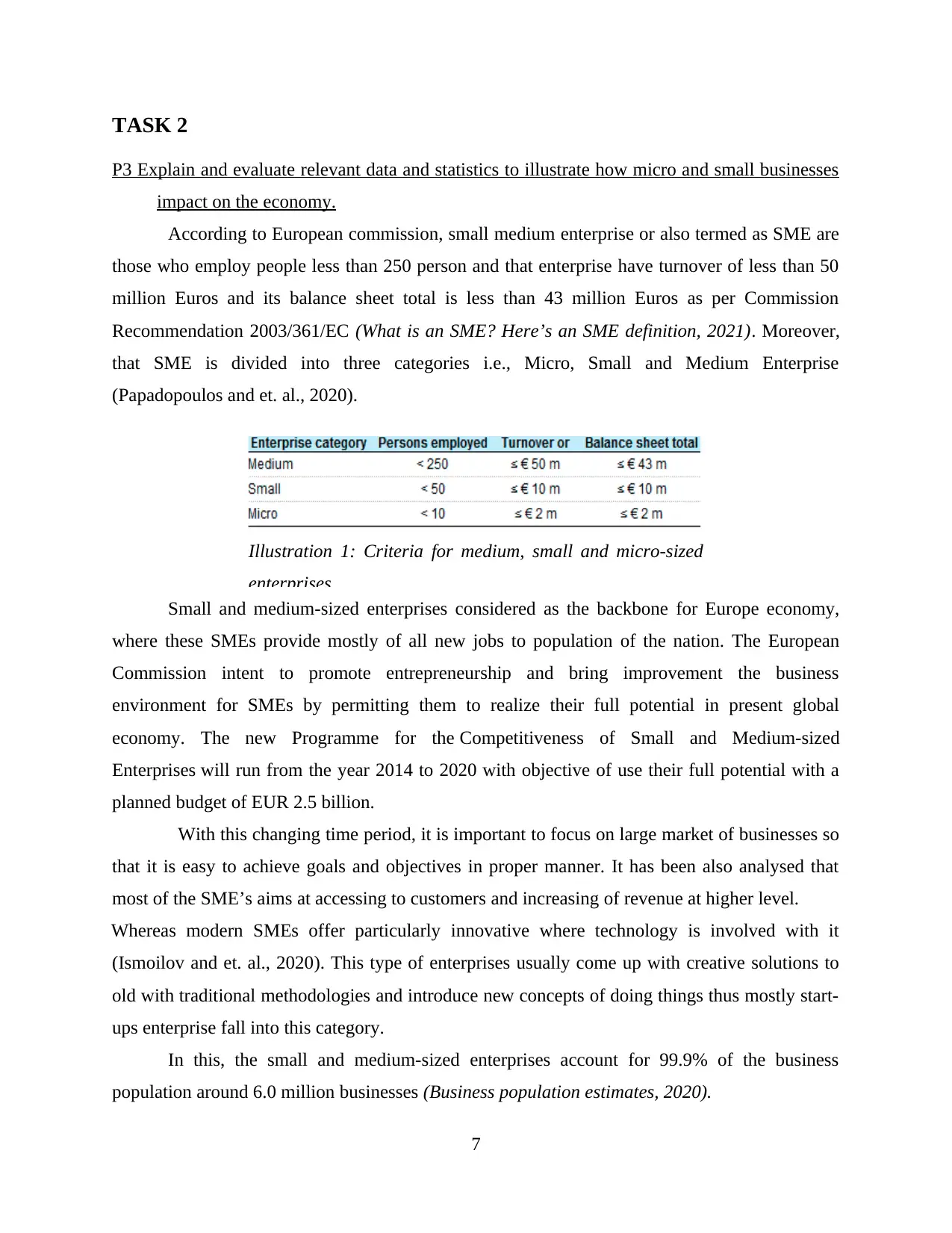
TASK 2
P3 Explain and evaluate relevant data and statistics to illustrate how micro and small businesses
impact on the economy.
According to European commission, small medium enterprise or also termed as SME are
those who employ people less than 250 person and that enterprise have turnover of less than 50
million Euros and its balance sheet total is less than 43 million Euros as per Commission
Recommendation 2003/361/EC (What is an SME? Here’s an SME definition, 2021). Moreover,
that SME is divided into three categories i.e., Micro, Small and Medium Enterprise
(Papadopoulos and et. al., 2020).
Small and medium-sized enterprises considered as the backbone for Europe economy,
where these SMEs provide mostly of all new jobs to population of the nation. The European
Commission intent to promote entrepreneurship and bring improvement the business
environment for SMEs by permitting them to realize their full potential in present global
economy. The new Programme for the Competitiveness of Small and Medium-sized
Enterprises will run from the year 2014 to 2020 with objective of use their full potential with a
planned budget of EUR 2.5 billion.
With this changing time period, it is important to focus on large market of businesses so
that it is easy to achieve goals and objectives in proper manner. It has been also analysed that
most of the SME’s aims at accessing to customers and increasing of revenue at higher level.
Whereas modern SMEs offer particularly innovative where technology is involved with it
(Ismoilov and et. al., 2020). This type of enterprises usually come up with creative solutions to
old with traditional methodologies and introduce new concepts of doing things thus mostly start-
ups enterprise fall into this category.
In this, the small and medium-sized enterprises account for 99.9% of the business
population around 6.0 million businesses (Business population estimates, 2020).
7
Illustration 1: Criteria for medium, small and micro-sized
enterprises
P3 Explain and evaluate relevant data and statistics to illustrate how micro and small businesses
impact on the economy.
According to European commission, small medium enterprise or also termed as SME are
those who employ people less than 250 person and that enterprise have turnover of less than 50
million Euros and its balance sheet total is less than 43 million Euros as per Commission
Recommendation 2003/361/EC (What is an SME? Here’s an SME definition, 2021). Moreover,
that SME is divided into three categories i.e., Micro, Small and Medium Enterprise
(Papadopoulos and et. al., 2020).
Small and medium-sized enterprises considered as the backbone for Europe economy,
where these SMEs provide mostly of all new jobs to population of the nation. The European
Commission intent to promote entrepreneurship and bring improvement the business
environment for SMEs by permitting them to realize their full potential in present global
economy. The new Programme for the Competitiveness of Small and Medium-sized
Enterprises will run from the year 2014 to 2020 with objective of use their full potential with a
planned budget of EUR 2.5 billion.
With this changing time period, it is important to focus on large market of businesses so
that it is easy to achieve goals and objectives in proper manner. It has been also analysed that
most of the SME’s aims at accessing to customers and increasing of revenue at higher level.
Whereas modern SMEs offer particularly innovative where technology is involved with it
(Ismoilov and et. al., 2020). This type of enterprises usually come up with creative solutions to
old with traditional methodologies and introduce new concepts of doing things thus mostly start-
ups enterprise fall into this category.
In this, the small and medium-sized enterprises account for 99.9% of the business
population around 6.0 million businesses (Business population estimates, 2020).
7
Illustration 1: Criteria for medium, small and micro-sized
enterprises
Paraphrase This Document
Need a fresh take? Get an instant paraphrase of this document with our AI Paraphraser
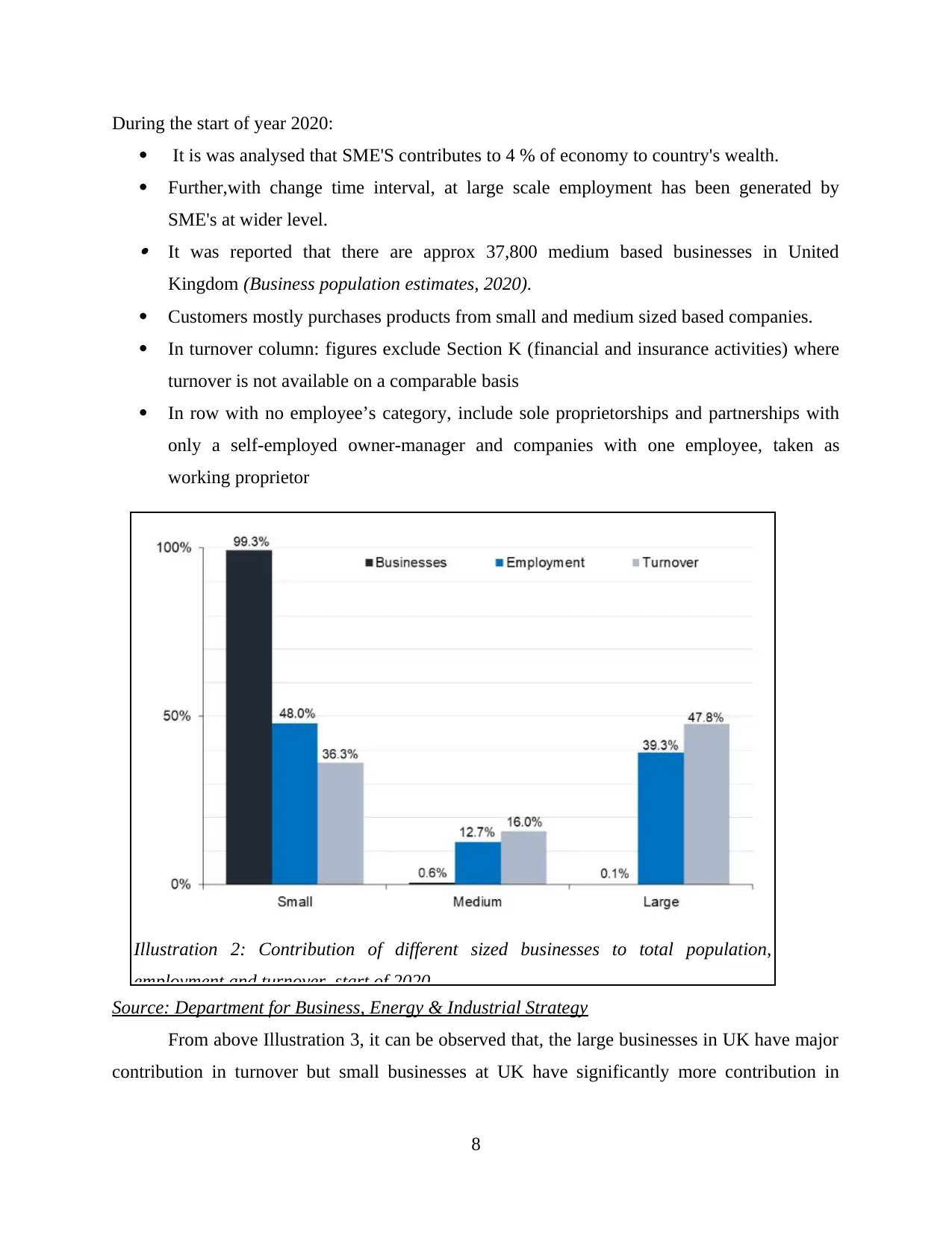
During the start of year 2020:
It is was analysed that SME'S contributes to 4 % of economy to country's wealth.
Further,with change time interval, at large scale employment has been generated by
SME's at wider level. It was reported that there are approx 37,800 medium based businesses in United
Kingdom (Business population estimates, 2020).
Customers mostly purchases products from small and medium sized based companies.
In turnover column: figures exclude Section K (financial and insurance activities) where
turnover is not available on a comparable basis
In row with no employee’s category, include sole proprietorships and partnerships with
only a self-employed owner-manager and companies with one employee, taken as
working proprietor
Source: Department for Business, Energy & Industrial Strategy
From above Illustration 3, it can be observed that, the large businesses in UK have major
contribution in turnover but small businesses at UK have significantly more contribution in
8
Illustration 2: Contribution of different sized businesses to total population,
employment and turnover, start of 2020
It is was analysed that SME'S contributes to 4 % of economy to country's wealth.
Further,with change time interval, at large scale employment has been generated by
SME's at wider level. It was reported that there are approx 37,800 medium based businesses in United
Kingdom (Business population estimates, 2020).
Customers mostly purchases products from small and medium sized based companies.
In turnover column: figures exclude Section K (financial and insurance activities) where
turnover is not available on a comparable basis
In row with no employee’s category, include sole proprietorships and partnerships with
only a self-employed owner-manager and companies with one employee, taken as
working proprietor
Source: Department for Business, Energy & Industrial Strategy
From above Illustration 3, it can be observed that, the large businesses in UK have major
contribution in turnover but small businesses at UK have significantly more contribution in
8
Illustration 2: Contribution of different sized businesses to total population,
employment and turnover, start of 2020
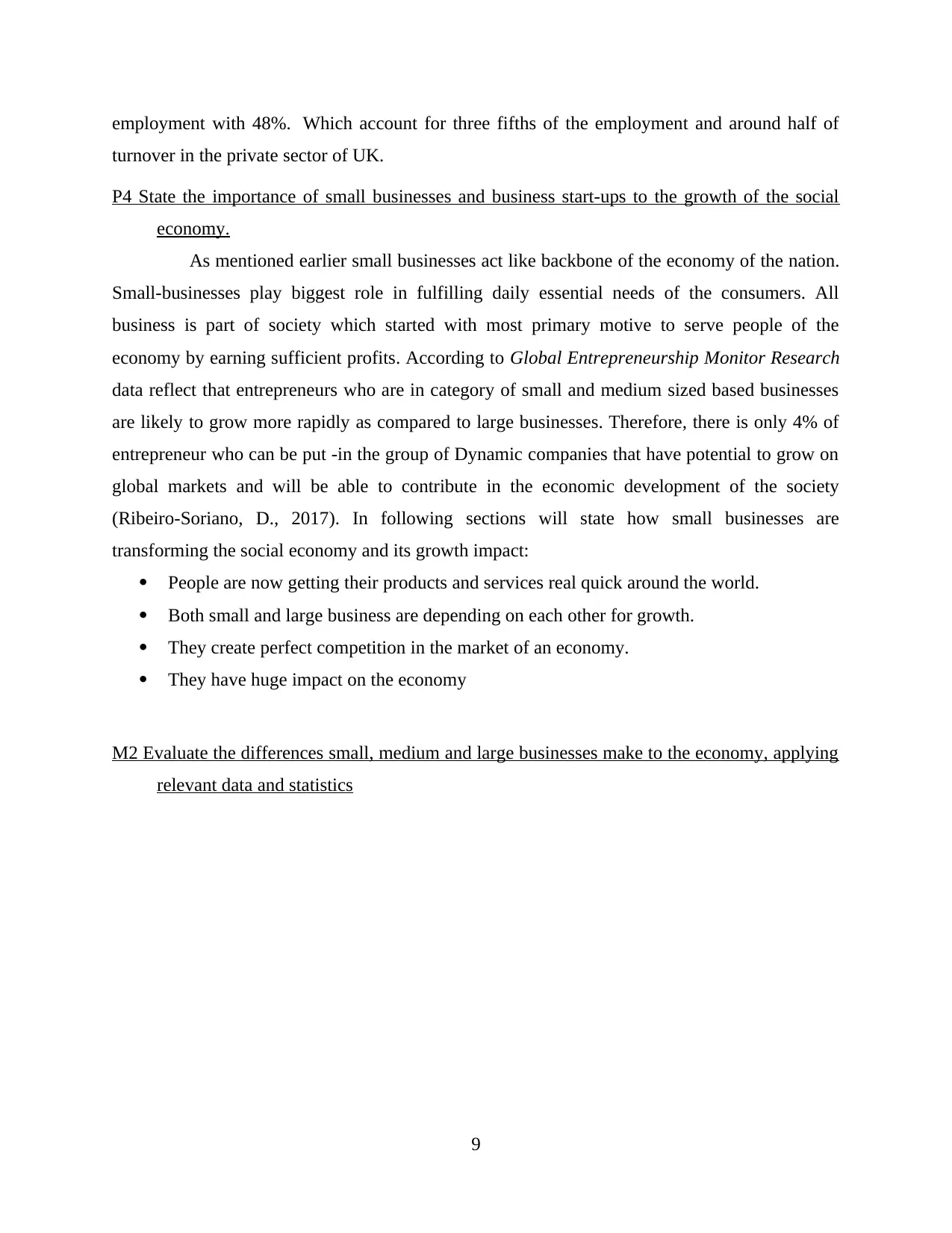
employment with 48%. Which account for three fifths of the employment and around half of
turnover in the private sector of UK.
P4 State the importance of small businesses and business start-ups to the growth of the social
economy.
As mentioned earlier small businesses act like backbone of the economy of the nation.
Small-businesses play biggest role in fulfilling daily essential needs of the consumers. All
business is part of society which started with most primary motive to serve people of the
economy by earning sufficient profits. According to Global Entrepreneurship Monitor Research
data reflect that entrepreneurs who are in category of small and medium sized based businesses
are likely to grow more rapidly as compared to large businesses. Therefore, there is only 4% of
entrepreneur who can be put -in the group of Dynamic companies that have potential to grow on
global markets and will be able to contribute in the economic development of the society
(Ribeiro-Soriano, D., 2017). In following sections will state how small businesses are
transforming the social economy and its growth impact:
People are now getting their products and services real quick around the world.
Both small and large business are depending on each other for growth.
They create perfect competition in the market of an economy.
They have huge impact on the economy
M2 Evaluate the differences small, medium and large businesses make to the economy, applying
relevant data and statistics
9
turnover in the private sector of UK.
P4 State the importance of small businesses and business start-ups to the growth of the social
economy.
As mentioned earlier small businesses act like backbone of the economy of the nation.
Small-businesses play biggest role in fulfilling daily essential needs of the consumers. All
business is part of society which started with most primary motive to serve people of the
economy by earning sufficient profits. According to Global Entrepreneurship Monitor Research
data reflect that entrepreneurs who are in category of small and medium sized based businesses
are likely to grow more rapidly as compared to large businesses. Therefore, there is only 4% of
entrepreneur who can be put -in the group of Dynamic companies that have potential to grow on
global markets and will be able to contribute in the economic development of the society
(Ribeiro-Soriano, D., 2017). In following sections will state how small businesses are
transforming the social economy and its growth impact:
People are now getting their products and services real quick around the world.
Both small and large business are depending on each other for growth.
They create perfect competition in the market of an economy.
They have huge impact on the economy
M2 Evaluate the differences small, medium and large businesses make to the economy, applying
relevant data and statistics
9
⊘ This is a preview!⊘
Do you want full access?
Subscribe today to unlock all pages.

Trusted by 1+ million students worldwide
1 out of 22
Related Documents
Your All-in-One AI-Powered Toolkit for Academic Success.
+13062052269
info@desklib.com
Available 24*7 on WhatsApp / Email
![[object Object]](/_next/static/media/star-bottom.7253800d.svg)
Unlock your academic potential
Copyright © 2020–2025 A2Z Services. All Rights Reserved. Developed and managed by ZUCOL.





